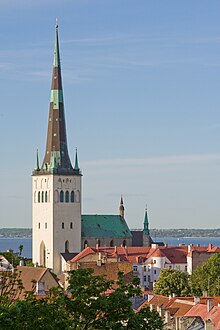
Back Estoniyada din Azerbaijani Рэлігія ў Эстоніі Byelorussian Рэлігія ў Эстоніі BE-X-OLD Θρησκεία στην Εσθονία Greek Religión en Estonia Spanish Religioon Eestis Estonian Uskonto Virossa Finnish Religion en Estonie French Religija u Estoniji Croatian Կրոնն Էստոնիայում Armenian
Religion in Estonia (2021)[1]
No religion (58.4%)
Eastern Orthodoxy (16.3%)
Lutheranism (7.7%)
Other Christians (2.7%)
Islam (0.5%)
Estonian Neopaganism (0.5%)
Buddhism (0.2%)
Other religions (0.9%)
Undeclared (12.7%)

Estonia, historically a Lutheran Christian nation,[2][3][4] is today one of the least religious countries in the world in terms of declared attitudes, with only 14 percent of the population declaring religion to be an important part of their daily life.[5] This is thought to largely be a result of the Soviet occupation of Estonia in 1940,[citation needed] prior to which Estonia had a large Christian majority.
- ^ Cite error: The named reference
Censuswas invoked but never defined (see the help page). - ^ Ivković, Sanja Kutnjak; Haberfeld, M.R. (10 June 2015). Measuring Police Integrity Across the World: Studies from Established Democracies and Countries in Transition. Springer. p. 131. ISBN 9781493922796.
Estonia is considered Protestant when classified by its historically predominant major religion (Norris and Inglehart 2011) and thus some authors (e.g., Davie 2003) claim Estonia belongs to Western (Lutheran) Europe, while others (e.g., Norris and Inglehart 2011) see Estonia as a Protestant ex-Communist society.
- ^ Cite error: The named reference
MarshallCavendish2010was invoked but never defined (see the help page). - ^ Rausing, Sigrid (2004). History, Memory, and Identity in Post-Soviet Estonia: The End of a Collective Farm. Oxford University Press. p. 96. ISBN 9780199263189.
Protestantism has done much to inform the moral world view of the Estonians, particularly the process of distinguishing themselves from the Russians.
- ^ "Estonians least religious in the world". EU Observer. 11 February 2009. Retrieved 9 January 2014.
© MMXXIII Rich X Search. We shall prevail. All rights reserved. Rich X Search